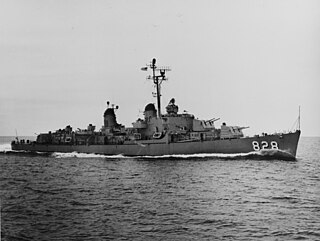USS Borie may refer to:
- USS Borie (DD-215), a Clemson-class destroyer commissioned in 1920, served in World War II and sunk following battle damage in 1943.
- USS Borie (DD-704), an Allen M. Sumner-class destroyer, commissioned in 1944 and decommissioned in 1972.

USS Borie (DD-215) was a Clemson-class destroyer in the United States Navy during World War II. She was the first ship named for Ulysses S. Grant's Secretary of the Navy, Adolph E. Borie. She served in the Black Sea, the Asiatic Fleet and the Caribbean between the wars, and in the Battle of the Atlantic, the long campaign to protect Allied shipping from German U-boats during World War II. As part of the antisubmarine Hunter-killer Group unit Task Group 21.14, the crew earned a Presidential Unit Citation for its "extraordinary performance." Borie also earned distinction in her final battle with U-405 in November 1943, and was sunk by friendly forces due to damage sustained by ramming the surfaced U-boat and engaging her crew with small arms fire.

The Clemson class was a series of 156 destroyers which served with the United States Navy from after World War I through World War II.

In naval terminology, a destroyer is a fast, maneuverable long-endurance warship intended to escort larger vessels in a fleet, convoy or battle group and defend them against smaller powerful short-range attackers. They were originally developed in the late 19th century by Fernando Villaamil for the Spanish Navy as a defense against torpedo boats, and by the time of the Russo-Japanese War in 1904, these "torpedo boat destroyers" (TBDs) were "large, swift, and powerfully armed torpedo boats designed to destroy other torpedo boats". Although the term "destroyer" had been used interchangeably with "TBD" and "torpedo boat destroyer" by navies since 1892, the term "torpedo boat destroyer" had been generally shortened to simply "destroyer" by nearly all navies by the First World War.
| This article includes a list of ships with the same or similar names. If an internal link for a specific ship led you here, you may wish to change the link to point directly to the intended ship article, if one exists. |







